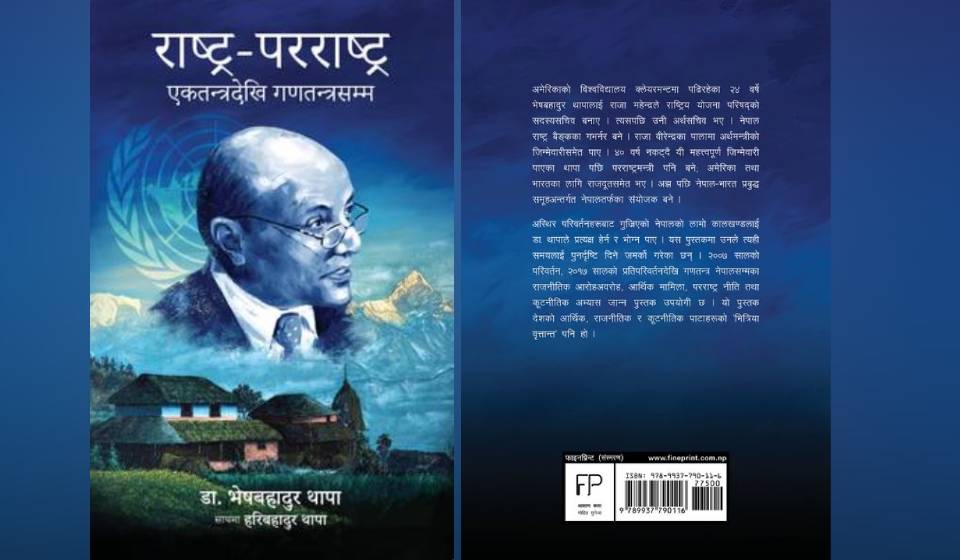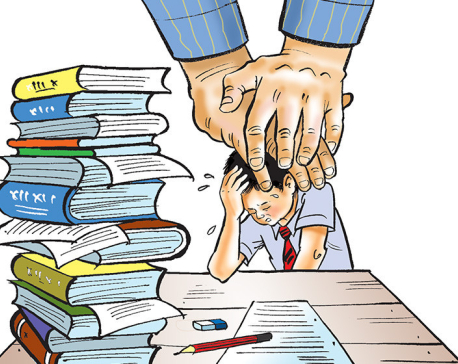
OR
Opinion
Inside-Outside the Corridors of Power
Published On: December 9, 2023 09:00 AM NPT By: Narayan Manandhar

Don’t judge a book by its cover. This phrase aptly applies to Dr. Bhek Bahadur Thapa’s memoire in Nepali Rastra-Pararastra: Ektantradekhi Ganatantrasamma. My English translation will read like Internal-External: From Autocracy to Republicanism.
The cover page is as drab as my own perception of Dr Thapa. However, after a complete read, my perception or rather misconception of Dr Thapa has to be changed. Personally, I used to take him as a royal stooge, a chameleon character that can change its color to suit the environment. He has always hung on to power circles whether during monarchy days, multi-party system or republicanism. I was wrong. Totally wrong. Maybe because I relied too much on what appeared in the media.
This is the reason why I decided to review. There is a second reason as well. The book is in Nepali and has limited access. Hopefully, there will be English translations for greater access to non-Nepali speakers.
The book is a treasure trove. In the language of research, we can call it “gold dust”. The memoir stretches nearly six decades of Dr Thapa’s “technocratic career” that he prefers to call. Other than contesting an election in 1992, he took no interest in partisan politics though majority of his appointments were political in nature.
Let me start with some pitfalls. First, the book is weaved in a chronological fashion. There are eight chapters dedicated to specific issues arranged in a chronological fashion but not in exact order. The readers who are not used to BS and AD can easily get confused or irritated by having to indulge in mental conversion of the dates and years. This is not a big deal. In one section when you read him as a minister and in the immediate section following you read him as an ambassador – one will get confused unless events are chronologically placed.
Second, on page 39, it is mentioned that China has made a written commitment to establish a paper factory in Nepalgunj, a cement factory in Hetauda and a leather and shoe factory in Kathmandu. A paper factory in Nepalgunj could have been changed to Bhrikuti Paper Mill in Gaidakot, but my understanding is that Hetauda Cement Factor was constructed as an Engineering-Consultancy model under ADB loan.
Third, it is irritating to read numerous budget figures, written to the thousands of rupees. I suppose this degree of accuracy is not needed. Presentations in terms of billions or millions would have been enough or could have been presented as percentage values would have done the job.
Here is a summary of Dr Thapa’s career: At a tender age of 24 years, while doing his PhD from Claremont Graduate School, he was hand-picked by King Mahendra, as the member-secretary of the then powerful Planning Council, the present day avatar of the National Planning Commission; then he went on to become the governor of the central bank, the finance secretary, the longest serving finance minister, two-time ambassador to the USA and one-time ambassador to India, and the foreign minister. His overseas ventures included vice-president of IDRC, Canada, UN resident representative in Sri Lanka, advisor to UN Volunteer, Geneva. At the end of his career, he was inducted as one of the four Eminent Persons Group (EPG) members from Nepal’s side. There were four members from India. The final report of the EPG has been submitted, but is in a state of limbo due to India’s undisclosed reservations. Robert McNamara, the Harvard “whiz kid” in Ford Motors, who became the president of the World Bank, invited him to join the bank but he refused on the ground that he just completed his tenure as Nepali ambassador to the USA. By the way, McNamara is also dubbed as makaimara (maize-killer) in Nepal due to the failure of maize cultivation under the bank-funded Rasuwa-Nuwakot Integrated Rural Development Project. During his stint with the UN, he could also have been deputy member secretary for the Asia Pacific Region.
Most exciting part of the memoir is that Dr Thapa holding key positions during critical times calling for critical decisions.
The book is spread with anecdotes, incidents, innuendos, and “what-if” that keeps the reader glued to the book. Here is my favorite: During a royal visit to the USA, Queen Ashwarya went for a shopping spree. She happened to shop in a departmental store spending a cool sum of US$150,000. But at the time of payment, the store refused to accept cash. The Nepalese royal entourage was carrying stacks of dollar bills. The cashier was not authorized to accept that much payment in cash. The USA had already switched to credit cards (page 162). Imagine the naivety of our royals? Want to have information like this? Read the memoir.
One thing good about his writing is Dr Thapa calling spade a spade, nothing in roundabouts. He had a chance to work under three kings and a number of prime ministers. As I read through the pages on three kings, I found him presenting Mahendra to be a visionary leader, Birendra to be polite but indecisive, and Gyanendra the worst of a kind. Sounds like he has a personal grudge with the last king for implicating him under the Carpet Scandal. Late Harka Gurung did told this scribe, during brief association with Transparency International Nepal Chapter, that they were made guinea pigs by the then all-powerful anti-corruption agency. In fact, saving this lone high profile corruption charges, the agency went into hibernation.
The memoir is a must for researchers studying Nepal-India relations, now almost projected at a level of love-hate relationships. No less than one-third of the material is devoted to Nepal-India relations. Spread under various sections, one can glean the evolutionary process right from PM Nehru’s displeasure with Mahendra’s takeover to clash with Indira Gandhi to Rajiv Gandhi. Forbidding Sonia Gandhi to visit Lord Pashupatinath Temple is being mentioned as the primary factor for souring personal relationship of Birendra with Rajhiv Gandhi. This could be one factor but I don’t see this as the main factor. Earlier, elsewhere I have read, during PM Tanka Pd Acharya, Ambedkar too was forbidden to visit the famed temple. Souring of Nepal-India relationships can be gleaned from writings on boundary disputes (remember Kalapani), trade and transit rights, 1950 treaty, periodic embargos, Bhutanese refugees, Maoist conflict, New Delhi agreement, importation of arms and finally, down to the establishment of EPG to sort out all contentious bilateral issues.
As I read through the pages of his memoir, I found him playing a crucial role in handling pressures put on by US President Jimmy Carter over human rights and democracy issues, establishment of CEDA with supports from Ford Foundation, founding member of JCs and Nepal Council of World Affairs, mobilizing funds from Kuwait for Kulekhani Hydro-Power, mediating Tamil Tigers in Sri Lanka, and holding further exodus of people of Nepalese origin from Bhutan. To cite an example of mobilizing Kuwaiti Fund, imagine the present-day situation of Nepal vis-à-vis Israel-Hamas war? During those days, Arabic countries held reservations with Nepal for being the first country from the Asia Pacific to recognize the state of Israel. Even during such hour, Dr Thapa managed to pull support from Kuwait to the tune of five million dinars. This is purely because of his personal connections.
Definitely, some people are born with silver spoons in their mouths. But there are few who can do the eating. Dr Bhekh Bahadur Thapa probably is the one who knew how to eat with the spoon. But I do get jolted when he writes that a salary of $900 per month was too limited to take care of the family of five in the USA and this forced spouses to work. If this is the case with the people inside and outside the power corridors why blame the exodus of youngsters for foreign employment?
You May Like This

Ensuring Food Safety Amidst Challenges
Kathmandu is renowned for its heritage and historical significance, attracting many tourists. The capital city offers an enormous variety of... Read More...

Modi's Moscow Mission: “Enduring and Expanding Partnership”
Indian Prime Minister Narendra Modi chose Russia for his first bilateral visit (July 8-9) in his third term. This is... Read More...

Challenges Facing the Nepali Education System
By the end of 8th grade, most schools stop teaching subjects like music, dance, art, and even sports, the very... Read More...







Just In
- NRB to provide collateral-free loans to foreign employment seekers
- NEB to publish Grade 12 results next week
- Body handover begins; Relatives remain dissatisfied with insurance, compensation amount
- NC defers its plan to join Koshi govt
- NRB to review microfinance loan interest rate
- 134 dead in floods and landslides since onset of monsoon this year
- Mahakali Irrigation Project sees only 22 percent physical progress in 18 years
- Singapore now holds world's most powerful passport; Nepal stays at 98th












Leave A Comment